Acute Myeloid Leukemia Affects Mouse Sperm Parameters, Spontaneous Acrosome Reaction, and Fertility Capacity
Abstract
:1. Introduction
2. Results
2.1. Effect of AML Cells, Cytarabine, and the Combination of Both on Mice Survival
2.2. Effect of AML Cells, Cytarabine, and the Combination of Both on Sperm Concentration
2.3. Effect of AML Cells, Cytarabine, and the Combination of Both on Sperm Motility
2.4. Effect of AML Cells, Cytarabine, and the Combination of both on Sperm Morphology
2.5. Effect of AML Cells, Cytarabine, and the Combination of Both on Spontaneous Sperm Acrosome Reaction
2.6. Effect of AML Cells, Cytarabine, and the Combination of Both on Mouse Fertility Capacity and Number of Delivered Offspring
3. Discussion
4. Materials and Methods
4.1. Animals
4.2. C1498/Cell-Line Preparation and Injection
4.3. Cytarabine Preparation and Injection
4.4. Sperm Extraction from Epididymis
4.5. Sperm Concentration and Motility Measurement
4.6. Morphology Measurement
4.7. Assessment of Sperm Acrosome Reaction
4.8. Fertility Capacity Test
Author Contributions
Funding
Acknowledgments
Conflicts of Interest
References
- Tournaye, H.; Goossens, E.; Verheyen, G.; Frederickx, V.; De Block, G.; Devroey, P.; Van Steirteghem, A. Preserving the reproductive potential of men and boys with cancer: Current concepts and future prospects. Hum. Reprod. Update 2004, 10, 525–532. [Google Scholar] [CrossRef] [PubMed]
- Bramswig, J.H.; Heimes, U.; Heiermann, E.; Schlegel, W.; Nieschlag, E.; Schellong, G. The effects of different cumulative doses of chemotherapy on testicular function. Results in 75 patients treated for Hodgkin’s disease during childhood or adolescence. Cancer 1990, 65, 1298–1302. [Google Scholar] [PubMed]
- Siimes, M.A.; Rautonen, J. Small testicles with impaired production of sperm in adult male survivors of childhood malignancies. Cancer 1990, 65, 1303–1306. [Google Scholar] [CrossRef] [Green Version]
- Heikens, J.; Behrendt, H.; Adriaanse, R.; Berghout, A. Irreversible gonadal damage in male survivors of pediatric Hodgkin’s disease. Cancer 1996, 78, 2020–2024. [Google Scholar] [CrossRef]
- Nurmio, M.; Keros, V.; Lahteenmaki, P.; Salmi, T.; Kallajoki, M.; Jahnukainen, K. Effect of childhood acute lymphoblastic leukemia therapy on spermatogonia populations and future fertility. J. Clin. Endocrinol. Metab. 2009, 94, 2119–2122. [Google Scholar] [CrossRef] [PubMed]
- Muller, J.; Sonksen, J.; Sommer, P.; Schmiegelow, M.; Petersen, P.M.; Heilman, C.; Schmiegelow, K. Cryopreservation of semen from pubertal boys with cancer. Med. Pediatr. Oncol. 2000, 34, 191–194. [Google Scholar] [CrossRef]
- Relander, T.; Cavallin-Stahl, E.; Garwicz, S.; Olsson, A.M.; Willen, M. Gonadal and sexual function in men treated for childhood cancer. Med. Pediatr. Oncol. 2000, 35, 52–63. [Google Scholar] [CrossRef]
- Schmidt, K.L.; Larsen, E.; Bangsboll, S.; Meinertz, H.; Carlsen, E.; Andersen, A.N. Assisted reproduction in male cancer survivors: Fertility treatment and outcome in 67 couples. Hum. Reprod. 2004, 19, 2806–2810. [Google Scholar] [CrossRef] [PubMed]
- Lahteenmaki, P.M.; Arola, M.; Suominen, J.; Salmi, T.T.; Andersson, A.M.; Toppari, J. Male reproductive health after childhood cancer. Acta Paediatr. 2008, 97, 935–942. [Google Scholar] [CrossRef]
- Van Casteren, N.J.; van Santbrink, E.J.; van Inzen, W.; Romijn, J.C.; Dohle, G.R. Use rate and assisted reproduction technologies outcome of cryopreserved semen from 629 cancer patients. Fertil. Steril. 2008, 90, 2245–2250. [Google Scholar] [CrossRef]
- Agarwal, A.; Ranganathan, P.; Kattal, N.; Pasqualotto, F.; Hallak, J.; Khayal, S.; Mascha, E. Fertility after cancer: A prospective review of assisted reproductive outcome with banked semen specimens. Fertil. Steril. 2004, 81, 342–348. [Google Scholar] [CrossRef]
- Chapman, R.M.; Sutcliffe, S.B.; Malpas, J.S. Male gonadal dysfunction in Hodgkin’s disease. A prospective study. J. Am. Med. Assoc. 1981, 245, 1323–1328. [Google Scholar] [CrossRef]
- Rueffer, U.; Breuer, K.; Josting, A.; Lathan, B.; Sieber, M.; Manzke, O.; Grotenhermen, F.J.; Tesch, H.; Bredenfeld, H.; Koch, P.; et al. Male gonadal dysfunction in patients with Hodgkin’s disease prior to treatment. Ann. Oncol. 2001, 12, 1307–1311. [Google Scholar] [CrossRef] [PubMed]
- Hallak, J.; Kolettis, P.N.; Sekhon, V.S.; Thomas, A.J., Jr.; Agarwal, A. Sperm cryopreservation in patients with testicular cancer. Urology 1999, 54, 894–899. [Google Scholar] [CrossRef]
- Berthelsen, J.G.; Skakkebaek, N.E. Gonadal function in men with testis cancer. Fertil. Steril. 1983, 39, 68–75. [Google Scholar] [CrossRef]
- Chung, K.; Irani, J.; Knee, G.; Efymow, B.; Blasco, L.; Patrizio, P. Sperm cryopreservation for male patients with cancer: An epidemiological analysis at the University of Pennsylvania. Eur. J. Obstet. Gynecol. Reprod. Biol. 2004, 113, S7–S11. [Google Scholar] [CrossRef]
- Auger, J.; Sermondade, N.; Eustache, F. Semen quality of 4480 young cancer and systemic disease patients: Baseline data and clinical considerations. Basic Clin. Androl. 2016, 26, 3. [Google Scholar]
- Hotaling, J.M.; Lopushnyan, N.A.; Davenport, M.; Christensen, H.; Pagel, E.R.; Muller, C.H.; Walsh, T.J. Raw and test-thaw semen parameters after cryopreservation among men with newly diagnosed cancer. Fertil. Steril. 2013, 99, 464–469. [Google Scholar] [CrossRef]
- Ku, J.Y.; Park, N.C.; Jeon, T.G.; Park, H.J. Semen Analysis in Cancer Patients Referred for Sperm Cryopreservation before Chemotherapy over a 15-Year Period in Korea. World J. Mens Health 2015, 33, 8–13. [Google Scholar] [CrossRef]
- Hallak, J.; Kolettis, P.N.; Sekhon, V.S.; Thomas, A.J., Jr.; Agarwal, A. Cryopreservation of sperm from patients with leukemia: Is it worth the effort? Cancer 1999, 85, 1973–1978. [Google Scholar] [CrossRef]
- Johnson, M.D.; Cooper, A.R.; Jungheim, E.S.; Lanzendorf, S.E.; Odem, R.R.; Ratts, V.S. Sperm banking for fertility preservation: A 20-year experience. Eur. J. Obstet. Gynecol. Reprod. Biol. 2013, 170, 177–182. [Google Scholar] [CrossRef] [PubMed]
- Nicolini, F.E.; Alcazer, V.; Huguet, F.; Cony-Makhoul, P.; Heiblig, M.; Fort, M.P.; Morisset, S.; Guerci-Bresler, A.; Soula, V.; Sobh, M.; et al. CML patients show sperm alterations at diagnosis that are not improved with imatinib treatment. Leuk. Res. 2016, 48, 80–83. [Google Scholar] [CrossRef] [PubMed]
- Agarwal, A.; Allamaneni, S.S. Disruption of Spermatogenesis by the Cancer Disease Process. J. Natl. Cancer Inst. Monogr. 2005, 34, 9–12. [Google Scholar] [CrossRef] [PubMed]
- Meirow, D.; Schenker, J.G. Cancer and male infertility. Hum. Reprod. 1995, 10, 2017–2022. [Google Scholar] [CrossRef]
- Wigny, K.M.; van Dorp, W.; van der Kooi, A.L.; de Rijke, Y.B.; de Vries, A.C.; Smit, M.; Pluijm, S.M.; van den Akker, E.L.; Pieters, R.; Laven, J.S.; et al. Gonadal function in boys with newly diagnosed cancer before the start of treatment. Hum. Reprod. 2016, 31, 2613–2618. [Google Scholar] [CrossRef] [PubMed]
- Van Casteren, N.J.; Boellaard, W.P.; Romijn, J.C.; Dohle, G.R. Gonadal dysfunction in male cancer patients before cytotoxic treatment. Int. J. Androl. 2010, 33, 73–79. [Google Scholar] [CrossRef] [PubMed]
- Michailov, Y.; Lunenfeld, E.; Kapelushnik, J.; Huleihel, M. Leukemia and male infertility: Past, present, and future. Leuk. Lymphoma 2018. accepted. [Google Scholar] [CrossRef] [PubMed]
- Carroll, P.R.; Whitmore, W.F., Jr.; Herr, H.W.; Morse, M.J.; Sogani, P.C.; Bajorunas, D.; Fair, W.R.; Chaganti, R.S. Endocrine and exocrine profiles of men with testicular tumors before orchiectomy. J. Urol. 1987, 137, 420–423. [Google Scholar] [CrossRef]
- Krawczuk-Rybak, M.; Płonowski, M.; Solarz, E.; Sega-Pondel, D.; Kazanowska, B.; Zelazowska-Rutkowska, B.; Wysocka, J. Assessment of gonadal function in boys and adolescents at the diagnosis of neoplastic disease. J. Pediatr. Endocrinol. Metab. 2012, 25, 453–458. [Google Scholar] [CrossRef]
- Krawczuk-Rybak, M.; Solarz, E.; Wołczyński, S. Male gonadal function before and after chemotherapy in prepubertal boys. Rocz. Akad. Med. Bialymstoku 2004, 49, 126–128. [Google Scholar]
- Huleihel, M. Spermatogenesis in an Artificial Three-Dimensional System. Stem Cells 2012, 30, 2355–2360. [Google Scholar]
- Huleihel, M.; Nourashrafeddin, S.; Plant, T.M. Application of three-dimensional culture systems to study mammalian spermatogenesis, with an emphasis on the rhesus monkey (Macaca mulatta). Asian J. Androl. 2015, 17, 972–980. [Google Scholar] [CrossRef] [PubMed]
- Plant, T.M.; Marshall, G.R. The functional significance of FSH in spermatogenesis and the control of its secretion in male primates. Endocr. Rev. 2001, 22, 764–786. [Google Scholar] [CrossRef] [PubMed]
- França, L.R.; Hess, R.A.; Dufour, J.M.; Hofmann, M.C.; Griswold, M.D. The Sertoli cell: One hundred fifty years of beauty and plasticity. Andrology 2016, 4, 189–212. [Google Scholar] [CrossRef] [PubMed]
- Van Etten, R.A. Aberrant cytokine signaling in leukemia. Oncogene 2007, 26, 6738–6749. [Google Scholar] [CrossRef] [PubMed] [Green Version]
- Hsu, H.C.; Lee, Y.M.; Tsai, W.H.; Jiang, M.L.; Ho, C.H.; Ho, C.K.; Wang, S.Y. Circulating levels of thrombopoietic and inflammatory cytokines in patients with acute myeloblastic leukemia and myelodysplastic syndrome. Oncology 2002, 63, 64–69. [Google Scholar] [CrossRef]
- Dokter, W.H.; Tuyt, L.; Sierdsema, S.J.; Esselink, M.T.; Vellenga, E. The spontaneous expression of interleukin-1 beta and interleukin-6 is associated with spontaneous expression of AP-1 and NF-kappa B transcription factor in acute myeloblastic leukemia cells. Leukemia 1995, 9, 425–432. [Google Scholar]
- Griffin, J.D.; Rambaldi, A.; Vellenga, E.; Young, D.C.; Ostapovicz, D.; Cannistra, S.A. Secretion of interleukin-1 by acute myeloblastic leukemia cells in vitro induces endothelial cells to secrete colony stimulating factors. Blood 1987, 70, 1218–1221. [Google Scholar]
- Birkenkamp, K.U.; Esselink, M.T.; Kruijer, W.; Vellenga, E. Differential effects of interleukin-3 and interleukin-1 on the proliferation and interleukin- 6 protein secretion of acute myeloid leukemic cells; the involvement of ERK, p38 and STAT5. Eur. Cytokine Netw. 1999, 10, 479–490. [Google Scholar]
- Loveland, K.L.; Klein, B.; Puesch, D.; Indumathy, S.; Bergmann, M.; Loveland, B.E.; Hedger, M.P.; Schuppe, H.C. Cytokines in Male Fertility and Reproductive Pathologies: Immunoregulation and Beyond. Front. Endocrinol. 2017, 8, 307. [Google Scholar] [CrossRef]
- Lin, J.M.; Li, B.; Rimmer, E.; VanRoey, M.; Jooss, K. Enhancement of the anti-tumor efficacy of a GM-CSF–secreting tumor cell immunotherapy in preclinical models by cytosine arabinoside. Exp. Hematol. 2008, 36, 319–328. [Google Scholar] [CrossRef] [PubMed]
- World Health Organization. WHO Laboratory Manual for the Examination of Human Spermatozoa and Semen-Cervical Mucus Interaction, 3rd ed.; Cambridge University Press: Cambridge, UK, 1992; pp. 13–18. [Google Scholar]

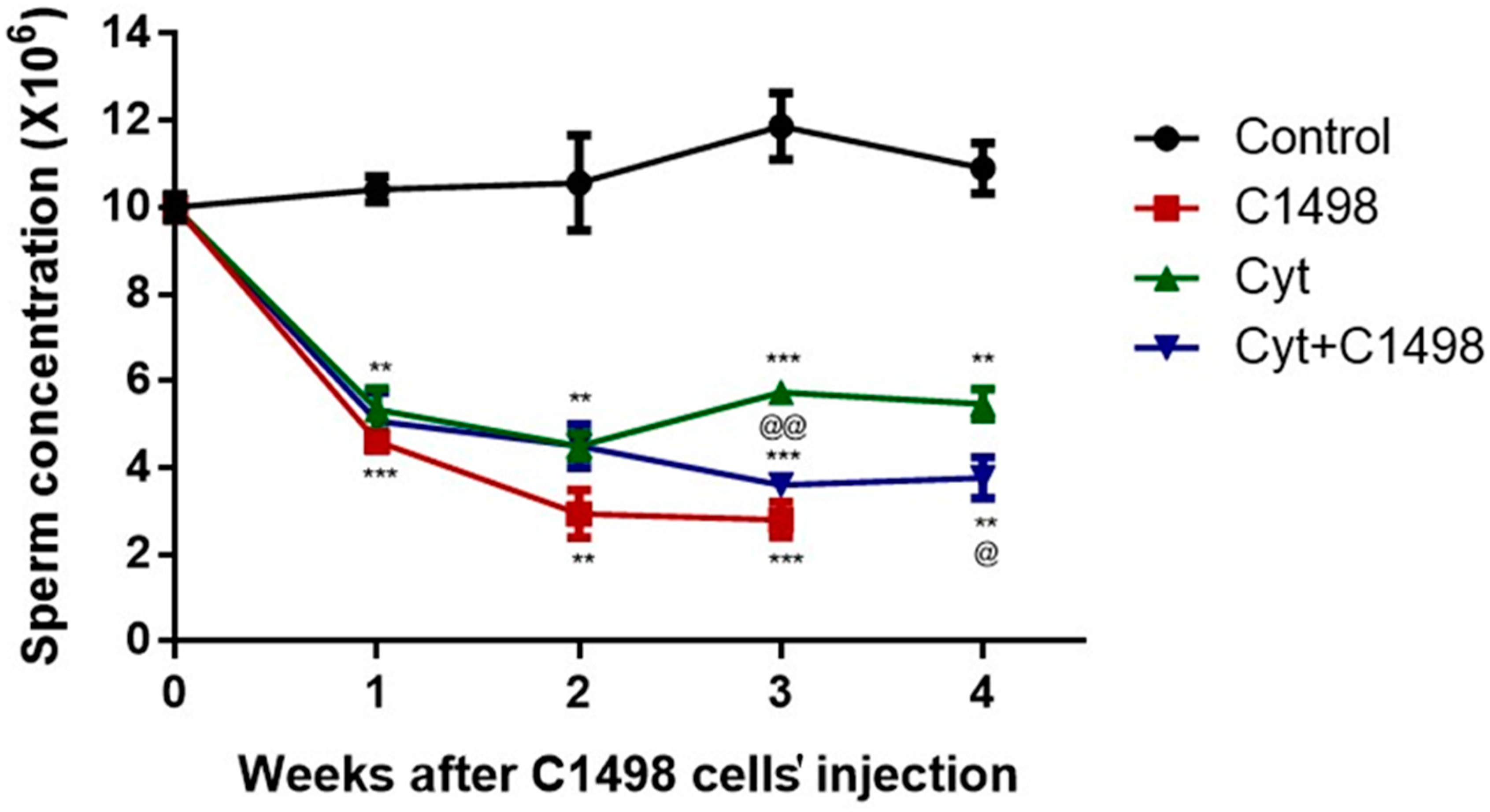
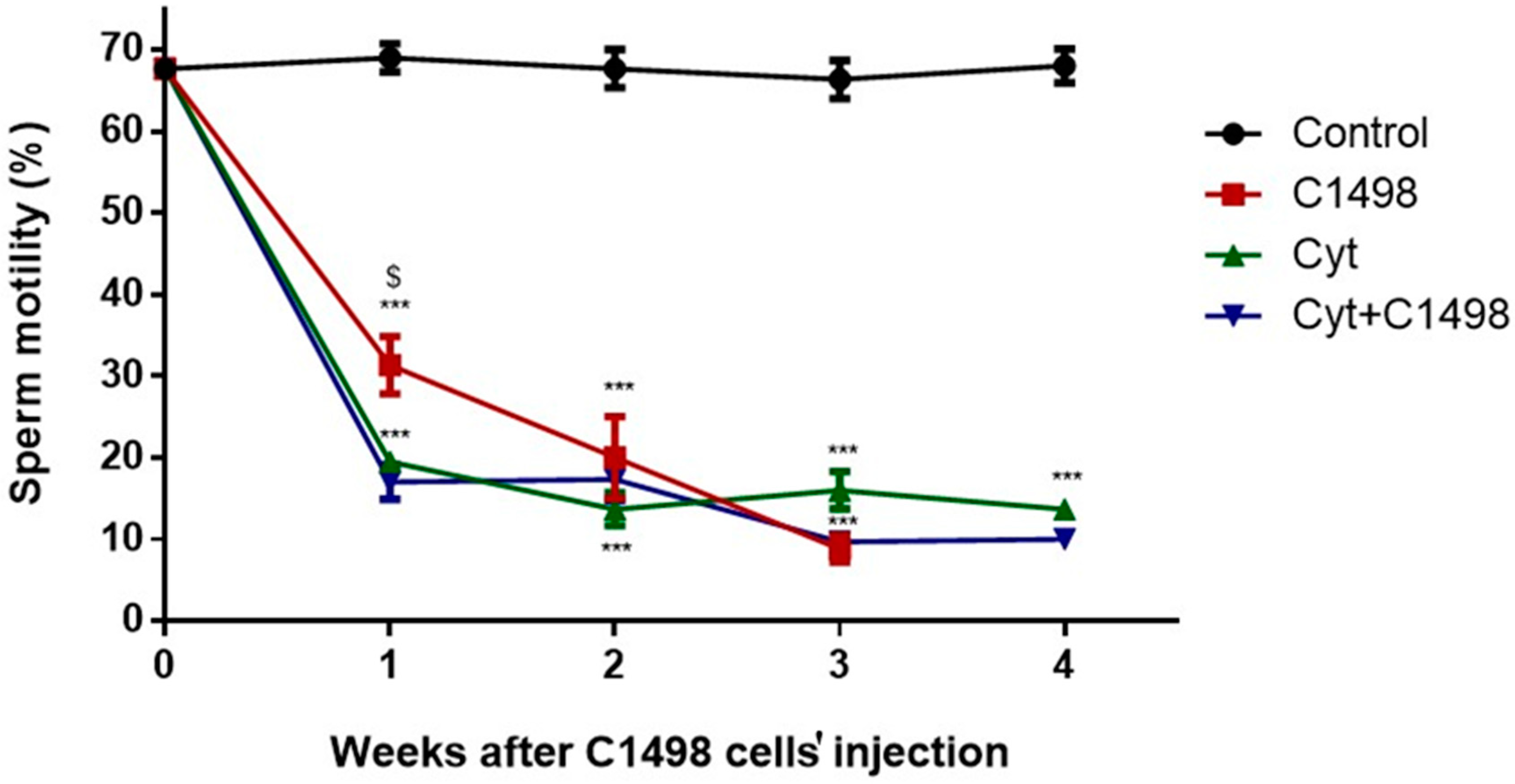
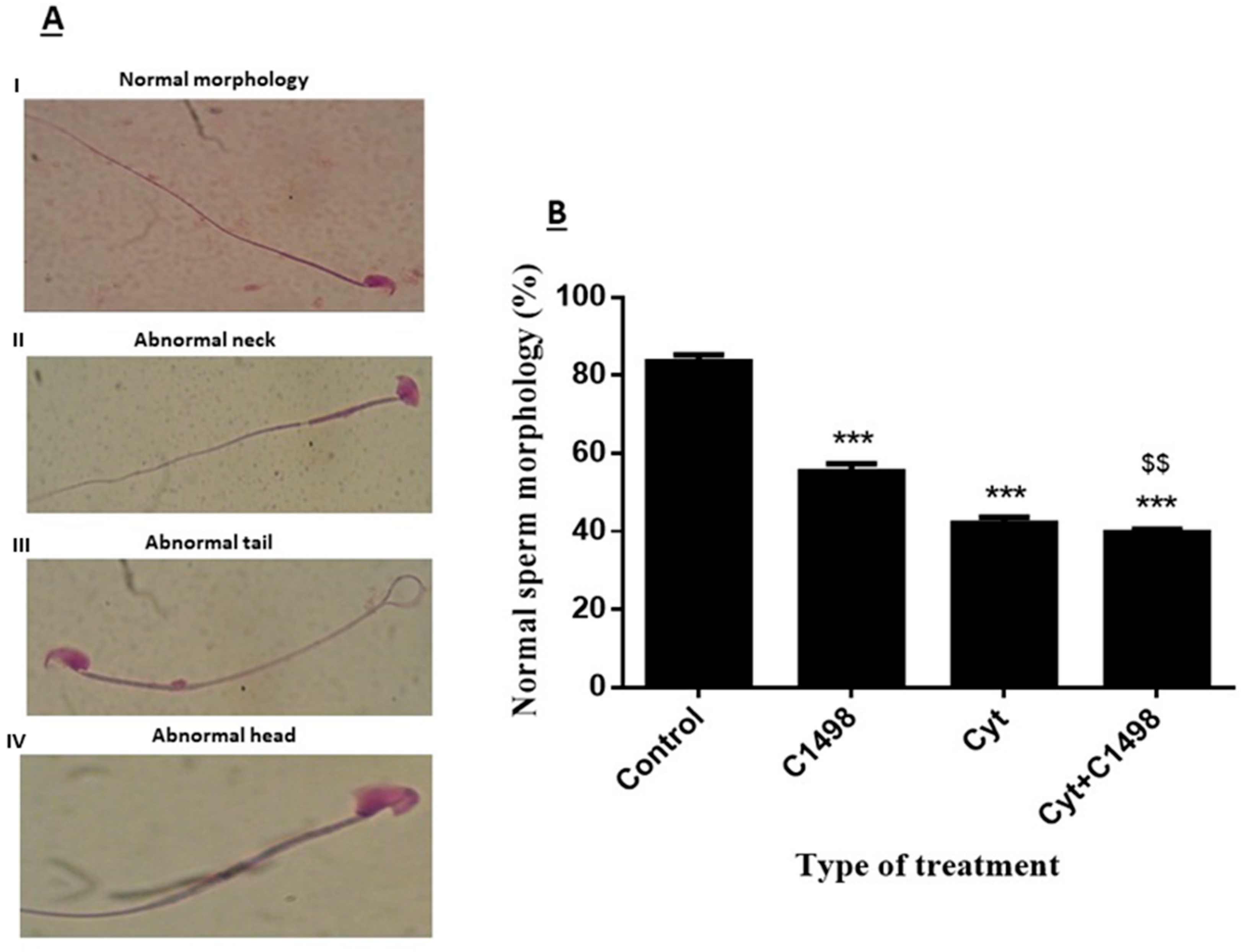
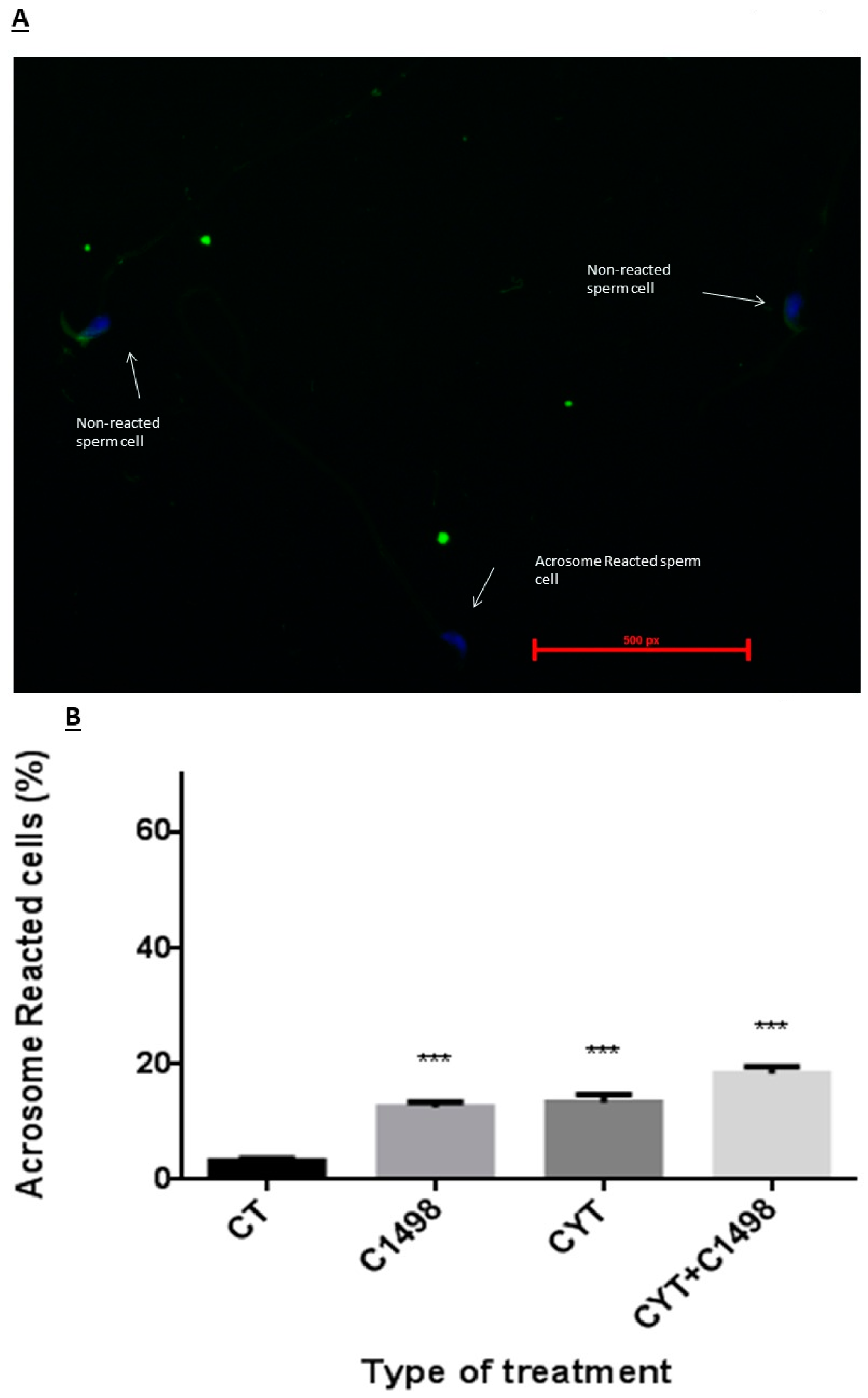
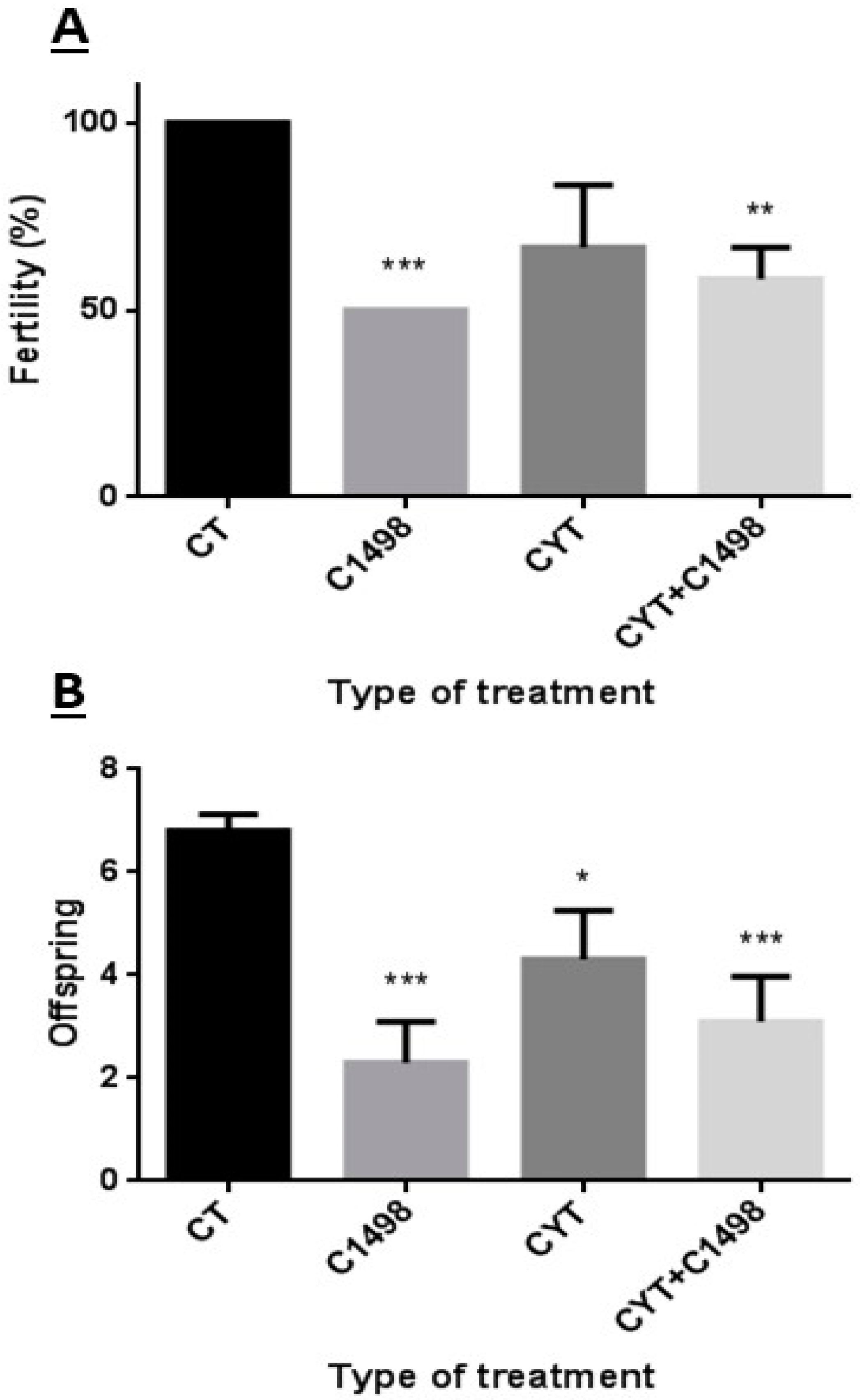
© 2019 by the authors. Licensee MDPI, Basel, Switzerland. This article is an open access article distributed under the terms and conditions of the Creative Commons Attribution (CC BY) license (http://creativecommons.org/licenses/by/4.0/).
Share and Cite
Michailov, Y.; Lunenfeld, E.; Kapilushnik, J.; Friedler, S.; Meese, E.; Huleihel, M. Acute Myeloid Leukemia Affects Mouse Sperm Parameters, Spontaneous Acrosome Reaction, and Fertility Capacity. Int. J. Mol. Sci. 2019, 20, 219. https://0-doi-org.brum.beds.ac.uk/10.3390/ijms20010219
Michailov Y, Lunenfeld E, Kapilushnik J, Friedler S, Meese E, Huleihel M. Acute Myeloid Leukemia Affects Mouse Sperm Parameters, Spontaneous Acrosome Reaction, and Fertility Capacity. International Journal of Molecular Sciences. 2019; 20(1):219. https://0-doi-org.brum.beds.ac.uk/10.3390/ijms20010219
Chicago/Turabian StyleMichailov, Yulia, Eitan Lunenfeld, Joseph Kapilushnik, Shevach Friedler, Eckart Meese, and Mahmoud Huleihel. 2019. "Acute Myeloid Leukemia Affects Mouse Sperm Parameters, Spontaneous Acrosome Reaction, and Fertility Capacity" International Journal of Molecular Sciences 20, no. 1: 219. https://0-doi-org.brum.beds.ac.uk/10.3390/ijms20010219



